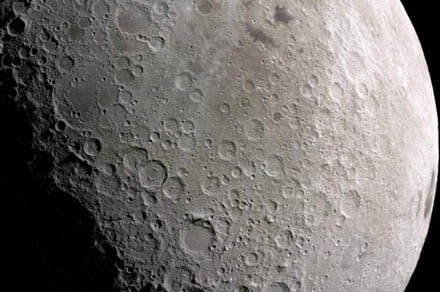NASA’s Goddard Space Flight Center
More than a dozen mysterious caverns lie hundreds of feet beneath the lunar surface, and NASA is considering a plan to send an extreme-terrain rover to rappel down and explore them. The reason? Caves could hold clues to the history of the Moon. Caverns may also provide ready-made habitats for future crewed missions, sheltering astronauts from the extreme temperatures, radiation, and asteroids that periodically impact the surface.
Called Moon Diver, the rover would hitch a ride on a rocket in the mid-2020s and touch down a few hundred feet from one of the moon’s deep pits on the Sea of Tranquility basin. There, it would deploy a smaller rover, Axel, to rappel hundreds of feet into the large pits that pockmark the lunar surface, reports Smithsonian Magazine. Instruments in the rover’s wheel wells would be used to analyze the caverns, collecting data on the ancient rock beneath the surface.
Moon Diver’s Axel rover rappels into a cavern. Artist’s rendition. NASA / JPL-Caltech
Astronauts Neil Armstrong and Buzz Aldrin traversed part of the Sea of Tranquility 50 years ago.
At the 50th Lunar and Planetary Science Conference on March 20, NASA scientists presented their plans for the mission. Laura Kerber, a NASA Jet Propulsion Laboratory researcher and principal investigator of the Moon Diver mission, said, “There is a nice poetry to this mission concept. Apollo 11 landed along the edge of the Sea of Tranquility. Fifty years later, we are going to dive down right into the middle of it.”
The Moon’s open caverns were formed when the ceilings collapsed into deep lava tubes under the Lunar surface. The exposed caverns would allow scientists to virtually time travel, giving them access to billion-year-old rock that could help researchers unravel the Lunar past.
To study the ancient Moon rocks, the two-wheeled Axel rover would be equipped with instruments including a variety of cameras for close-up and long-distance imaging of the walls. A microscope would be used to analyze the cavern’s mineral content. A spectrometer would analyze the chemistry of the rock.
The Moon Diver mission has been proposed as one of NASA’s low-cost missions. It will compete against proposals for missions to Neptune’s moon Triton and Jupiter’s satellite Io.
Editors’ Recommendations
- A lunar time capsule: 50-year-old moon rock samples to be opened for study
- Toyota shoots for the moon with its new lunar rover concept
- Trip to Neptune’s moon, Triton, could inform search for extraterrestrial life
- NASA’s Mars InSight lander is facing a rocky road as its drill hits a rock
- Tiny amounts of water bounce along the surface of the Moon

